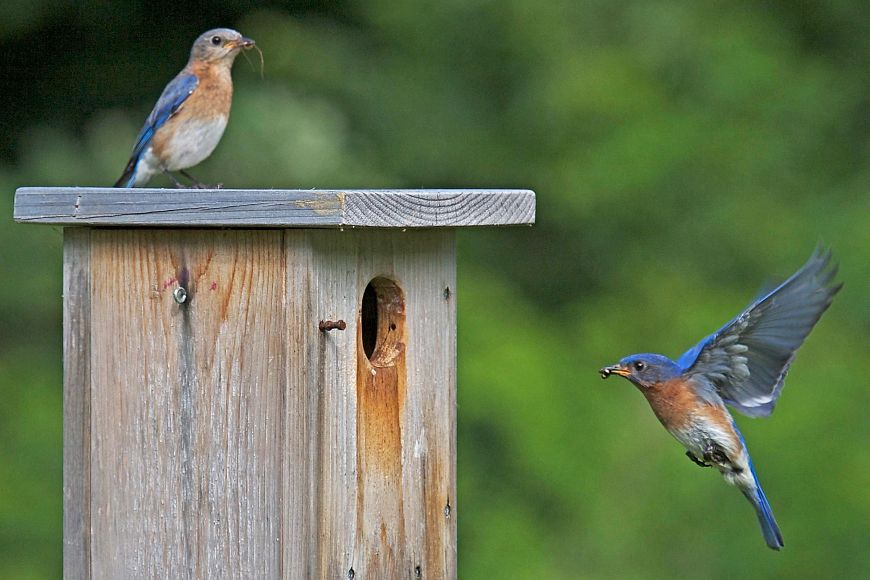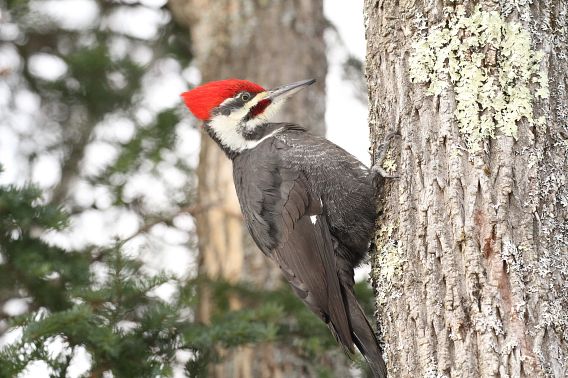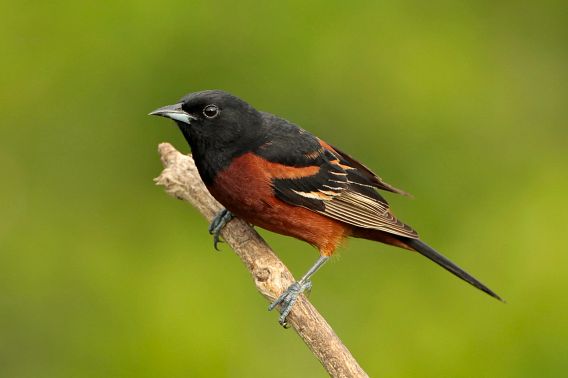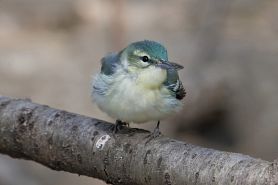All in to boost birds
Alarming drop in populations spurs actions around the state
Lisa Gaumnitz
IN THIS ISSUE: ABOUT BIRDS
 ©PATRICK READYEastern bluebird populations have rebounded with the help of nest boxes put up by the Bluebird Restoration Association of Wisconsin and others.
©PATRICK READYEastern bluebird populations have rebounded with the help of nest boxes put up by the Bluebird Restoration Association of Wisconsin and others.Lynn Christiansen of Saukville traded the perennials in her flower beds for native species and added dogwood trees, native grasses, shrubs and a bur oak. When she moves to a 3-acre site near Grafton this year, she plans to double down on native landscaping for birds.
Cattle producer Jerry Marr uses rotational grazing, enrolls some of his family’s 256 acres in northern Lafayette County in a federal program to conserve grasslands, and keeps plows off his hillsides so the eastern meadowlarks, bobolinks and Henslow’s sparrows find plenty of insects to eat and places to nest.
Wausau Bird Club members are restoring native trees and shrubs and removing invasive buckthorn on Barker-Stewart Island, located in the Wisconsin River in downtown Wausau, and carefully tending the new plantings during the summer. Members scoop water out of the river in buckets and carry them to the middle of the island to water the trees.
“We’re hoping to lure the migratory birds along the river with native plantings,” says Susan Haug, the club’s treasurer. “We hope they’ll have more of the foods they like instead of getting trapped in downtown Wausau with all of the taller buildings and glass windows to collide with.”
All across Wisconsin, people are adding native habitat and taking other steps to help the birds they love.
It’s exactly what conservationists say must happen if we are to save the birds that delight our eyes and ears, serve as pollinators, seed dispersers, pest control and food for other wildlife, and anchor a birdwatching industry that generated $107 billion nationally in economic impact, 666,000 jobs and $13 billion in tax revenue in 2011.
National studies are revealing a steep loss of birdlife in North America since 1970 as science hammers home the concept that conserving birds means protecting them throughout their life cycle.
“Before the early 2000s, the focus of bird conservation in North America was very much on protecting and restoring breeding grounds,” says Owen Boyle, species management chief for the DNR’s Natural Heritage Conservation Program.
While breeding grounds are obviously critical for bird productivity, if migratory birds die on the wintering grounds in Central or South America or while returning to Wisconsin, it doesn’t matter how good the breeding grounds are because there are fewer birds to use them, Boyle says.
“No matter where you live and no matter how much land you influence, you can have a positive impact for birds and the insect species that many of them depend on for food,” he says.
 ©RYAN BRADYWhile warblers, finches and swallows have seen declines, pileated woodpeckers (above) have benefited from conservation work and protections.
©RYAN BRADYWhile warblers, finches and swallows have seen declines, pileated woodpeckers (above) have benefited from conservation work and protections.NUMBERS CONFIRM WORST FEARS
Hard numbers now confirm what many bird lovers have noticed for years at their feeders, along roadsides and in fields and woods: Birds and birdsong are disappearing from our lives. North America has 2.9 billion fewer breeding birds than there were in 1970, representing a net loss of nearly 30%.
Those numbers, from a study published in Science magazine in September 2019, was based on long-term bird surveys and night radar showing spring migrations. Even common, beloved species have fallen off the cliff.
Evening grosbeak populations have plunged 90%, wood thrushes 60%, eastern meadowlarks 75% and dark-eyed juncos 50%, according to the research by seven leading bird conservation organizations including the Smithsonian Migratory Bird Center, Cornell University’s Lab of Ornithology and the American Bird Conservancy.
The only groups of birds doing well are raptors, waterfowl and woodpeckers, all conservation success stories reflecting, respectively, the ban on DDT and Endangered Species Act protections, public and private investment in wetland protection and restoration, and the maturation and protection of woodlands.
Trends in the state generally track the North American study results, based on data collected through the Wisconsin Breeding Bird Atlas II, a comprehensive five-year survey carried out by more than 2,000 volunteers partnering with the DNR, Wisconsin Society for Ornithology, the Western Great Lakes Bird and Bat Observatory and the Wisconsin Bird Conservation Partnership.
The only exception is that forest birds have fared better in Wisconsin, reflecting the rebound of our northern forests and their ability to provide important nesting areas for many species of warblers, thrushes, vireos and more.
HABITAT LOSS DRIVES DECLINE
While the North American study didn’t look specifically at causes for the declines, research has zeroed in on habitat loss, followed by habitat degradation due to fragmentation, invasive species and declining water quality, as the top two causes driving the declines.
“Habitat loss is the silent killer,” Boyle says.
Native landscapes have been cleared to make way for agriculture, development, resource extraction and other land uses, eliminating the native plants and natural communities that have evolved in Wisconsin over eons to support bird species that are year-round residents.
About 96% of all land birds feed their young insects, and native plants support a ready supply. Chickadees bring mostly caterpillars home to their young, one caterpillar every three minutes, according to Doug Tallamy, a University of Delaware entomologist and author of “Bringing Nature Home: How You Can Sustain Wildlife with Native Plants.”
That’s 350 to 570 caterpillars every day for each of the 16 to 18 days it takes the chicks to fledge.
Oak trees support 534 species of moths and butterflies, which in turn provide food for many birds including those migrating from neotropical wintering grounds to nesting sites in Wisconsin. Oaks also offer vital nesting cavities for owls, woodpeckers, nuthatches and bluebirds, Tallamy writes.
Native plants have evolved along with the insects that eat them, which are able to detoxify and digest the native plants. Most insects lack the enzymes necessary to eat non-native plants, like the ornamental trees and other plants so common in landscaping. Up to 90% of the world’s plant-eating insects can feed only on a small selection of plant species.
Research showed that in East Coast suburban neighborhoods where less than 70% of native vegetation remains — and that means most neighborhoods — the birds do not have the insects and seeds they need to eat and are having trouble reproducing, says the DNR’s Craig Thompson, a migratory bird expert who leads the Natural Heritage Conservation Program’s Integration Section.
“85% of Wisconsin is privately owned,” Thompson says. “So what happens on private lands really matters for birds.”
IMPORTANCE OF NATIVE PLANTS
Like her parents, Christiansen fed birds mainly at feeders until inspired by a 2011 “Grosbeaks Galore: Birds on Your Landscape” workshop put on by the DNR and partners in the Wisconsin Stopover Initiative. Tallamy was a featured speaker.
“That seminar was a complete eye-opener for me,” Christiansen says. “It brought home that bird feeding isn’t the end-all-be-all to support birds. Native plants are more important to supporting birds in the long run.”
She still provides bird feeders but started adding as many native plants as she could to her Saukville yard and enrolled in landscaping classes at Milwaukee Area Technical College with a goal of creating a bird haven and beautiful native landscape at their new house. She’s learned that landscaping isn’t just about looks.
“Don’t just plant something because that’s what they sell at the store. Plant something to benefit insects and birds,” she says. “It’s a good thing when insects are eating your plants.”
 ©JAMES KINDERMANBirds like the orchard oriole are big gainers thanks to conservation work and protections.
©JAMES KINDERMANBirds like the orchard oriole are big gainers thanks to conservation work and protections.KEEPING A LEGACY ALIVE
Tallgrass prairies are among the most decimated and threatened natural communities in the Midwest and the world. In Wisconsin, less than 10,000 acres, or 0.5% remain.
Working farms like the one Marr and his family have farmed for three generations are vital for providing the open habitat grassland birds need. Together with remnant prairies, the pastures, hayfields and conservation lands of these farms form a growing patchwork of lands helping to stem — and hopefully reverse — a steep decline in grassland birds.
Marr is manager and part owner of the family farm and is proud to play a role in saving grassland birds. He credits his father, Robert, for teaching him and siblings Richard, Greg, Jim and Mary Jean to care for the land.
“My dad was a great conservationist,” he says, noting that Robert received “about every county conservation award there is. His attitude was always, ‘Do what’s best for the land.’”
The elder Marr put some of his land into the USDA’s Conservation Reserve Program to keep it as grassland, knowing the program would allow the family to maintain income but also reduce work. He never plowed the hillside, preserving the soils, reducing runoff and nurturing native plants that produced a bumper crop of insects for birds and other wildlife.
“We all worked very hard after my dad bought the land to plant trees and maintain the farm,” Jerry Marr says. “To get it to this point was a huge family effort.”
Robert passed away in 1992 and the farm was put into a trust. Richard Marr and his wife, Kitty, and their children ran the farm for 25 years before Jerry Marr started managing it.
All along, the family has followed the same grassland management practices benefiting their cattle operation and birds, even as many farms in the region switched to row crops. Jerry Marr takes pride in seeing the fields alive with bobolinks, eastern meadowlarks, upland sandpipers and Henslow’s sparrows — all species declining precipitously.
“I can think of many times a meadowlark perched on the top wire of a bird wire fence with a beak full of insects,” he says. “As I’m out there checking cattle and spending time in the grassland, just to hear the birds and see them … it’s just good for the soul.”
WAUSAU FLIES HIGH FOR BIRDS
The growing scientific understanding that urban areas could provide important habitat helped spur the creation in 2009 of Bird City Wisconsin to recognize municipalities for their bird conservation and education activities.
To date, 111 communities have attained Bird City status and 25 have qualified as “High Flyers.” Wausau is one of them, thanks in large part to the Wausau Bird Club in cooperation with the Wausau and Marathon County Parks, Recreation and Forestry Department.
In addition to the habitat work on Barker-Stewart Island and a native plant garden at Monk Botanical Gardens, members have engaged youth groups in building nest boxes and planned a bluebird trail project with a local middle school (put on hold during the COVID-19 pandemic). They have participated in bird surveys and documented a state-threatened warbler species at Nine Mile County Forest, which Haug hopes can help protect the bird’s habitat.
Also in Wausau, several golf courses host bluebird trails, one has obtained an exemption to the mowing ordinance to let areas go natural by adding native plantings, and still another is a “Certified Audubon Cooperative Sanctuary.”
The city uses dark sky friendly outdoor light fixtures when possible to direct light to the ground, reducing light pollution and allowing birds to better see the stars needed for navigation.
“We’re proud of the efforts the city and other partners are doing,” Haug says. “We feel it’s important to do at least the little we can.
“People in the club just appreciate birds — their beautiful colors, their songs — just seeing them in their backyard.”
Lisa Gaumnitz is a natural resources educator and program and policy analyst for the DNR.
Book HIGHLIGHTS Lake Michigan stopover sites
Weighing in at one-third of an ounce — roughly the same as two nickels — the beautiful sky-blue cerulean warbler flies 5,000 miles roundtrip between wintering grounds in South America’s Andes Mountains and summer nesting grounds in Wisconsin’s hardwood forests.
Stopover sites where the warbler and Wisconsin’s other 200-plus migratory bird species can rest and refuel are crucial to their individual survival and to the overall fate of their species.
 ©JEREMY MEYERThis cerulean warbler was photographed in May at Milwaukee's Whitnall Park, a migratory bird stopover site.
©JEREMY MEYERThis cerulean warbler was photographed in May at Milwaukee's Whitnall Park, a migratory bird stopover site.North American numbers of cerulean warblers have dropped 70% in the last half-century. The species is listed as threatened in Wisconsin, and disappearing habitat on nesting, wintering and migratory grounds imperil the bird.
Sites in Wisconsin’s Lake Michigan coastal counties are particularly important as these warblers and other species tend to follow the shoreline and rely on coastal habitats, from sometimes just a few yards up to a few miles inland.
Now, the most important of these sites are identified in a book aimed at helping spur full protection and long-term conservation of sites. Stopovers are categorized as “fire escapes,” “convenience stores” or “full-service hotels” based on their ability to shelter or refuel birds.
“Birds are at greatest peril during long migrations, so the long-term conservation of the sites are critical for conserving the birds we love,” says Sumner Matteson, a DNR avian ecologist and an author, along with now retired DNR colleague Kim Grveles and Kim Kreitinger, outreach coordinator for the Natural Resources Foundation of Wisconsin.
The book, “A Planning Tool for Migratory Bird Conservation Along Lake Michigan,” includes maps and detailed information on more than 40 stopover sites. A full PDF of the book is available on the DNR website; go to dnr.wi.gov and search “birding.” The link can be found under the "How to Help" tab.
The book also has been provided to nearly 100 Lake Michigan coast city officials, conservation organizations, bird clubs and land managers.
“We hope that local and regional planners and conservation groups will use our document to factor in the importance of migratory bird habitat as they consider how best to manage and conserve landscapes along the Lake Michigan shore,” Matteson says.
The book is a partnership of the DNR, Wisconsin Stopover Initiative, Natural Resources Foundation and Wisconsin Coastal Management Program.
“We’ve received a lot of positive feedback from our stakeholders about the publication,” Kreitinger says. “We know that conservation partners are referencing it.”
While the book is aimed at planners, land managers and local decision makers, it offers a wealth of information birders can use to guide their birdwatching and to advocate for long-term conservation of the sites, Matteson says.
“Twice a year, one of the great natural spectacles occurs,” he says of bird migration. “Go out this fall or spring to one or more of the sites in our book and observe the variety of birds passing through our state.
“You will marvel at what you see!”
— Lisa Gaumnitz

